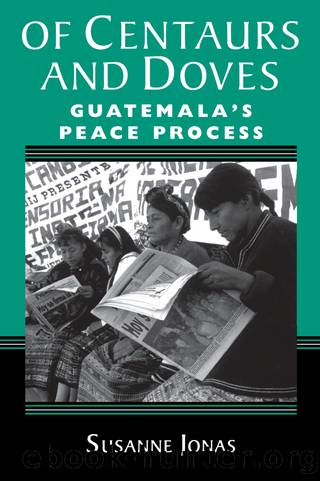Of Centaurs and Doves: Guatemala's Peace Process by Susanne Jonas

Author:Susanne Jonas [Jonas, Susanne]
Language: eng
Format: epub
Tags: Political Science, General
ISBN: 9780429967146
Google: 7__EDwAAQBAJ
Goodreads: 38497072
Publisher: Routledge
Published: 2018-02-06T00:00:00+00:00
Subtext of the Gerardi Assassination: Return of Political Violence in 1998?
Throughout the second half of 1997 and the first months of 1998, there was an eerie compás de espera (interval, hiatus, waiting period) on the peace front, a dynamic of one step forward, two steps backward, against a societal backdrop of dramatically increasing delincuencia (common crime) and deteriorating social conditions. By early 1998, the shadow of the 1999 general elections already loomed over virtually every political move by every political actor. All of these dynamics came into sharp relief in February 1998, with the government's disastrous retreat on tax reformâa political setback for the peace process as a whole (see Chapter 7). More generally, as MINUGUA (1998a, 16) noted in its verification report covering the first half of 1998, there was a "noticeable slowing down" of the peace process after the beginning of 1998 as compared with 1997.
But nothing in that panoramaârather typical for Guatemala and perhaps, more generally, for post-conflict societies attempting to make controversial reformsâprepared Guatemalans to wake up on the morning of April 27, 1998, to the televised images of Msgr. Juan Gerardi's bloodied skull, crushed by a cement block and spread across the floor of his garage the previous night. The corpse of Gerardi, Auxiliary Bishop and one of the leading figures of the Catholic Church's Bishops Conference, could be identified only by the ring on his finger, the only object of value. The method of assassination was designed to be grotesque, the message an unmistakable reminder of the worst atrocities of the war. But the war was over; this was the kind of political crime that was supposed to have ended forever with the signing of peace. At the time, no one could prove a political motive; but the assassination just happened to occur two nights after Gerardi's high-profile presentation of the monumental report on the war's human rights crimes. The report had been prepared by the Archbishop's Human Rights Office (ODHA) that Gerardi headed. Based on testimony taken from 6,000 civilians nationwide during three years, the report, ironically titled Nunca Más ("Never Again"), made clear that the overwhelming majority of these crimes (over 85 percent) had been committed by the army and related paramilitary forces, less than 10 percent by the URNG (see ODHA 1998).
"Peacetime violence" was nothing new; in Guatemala, as in the early years of all postwar transitions, social violence increased exponentially. But this was a different kind of peacetime crime; As the highest-level political assassination in recent Guatemalan history, it left the nation in a state of shock. Nothing after the assassination would be quite the same as before. Perhaps because the wounds of war were so far from being healed, it raised the specter of a return to the past. In its aftermath, many habits and behaviors engrained from thirty-six years of war reemerged, making the challenges of building (or even thinking about) a new society much more daunting than previously. By mid-1999, the murder remained unsolved and strong leads pointing to army or EMP involvement had not been followed up.
Download
This site does not store any files on its server. We only index and link to content provided by other sites. Please contact the content providers to delete copyright contents if any and email us, we'll remove relevant links or contents immediately.
| Belize | Costa Rica |
| El Salvador | Guatemala |
| Honduras | Nicaragua |
| Panama |
Cat's cradle by Kurt Vonnegut(15155)
Pimp by Iceberg Slim(14321)
4 3 2 1: A Novel by Paul Auster(12263)
Underground: A Human History of the Worlds Beneath Our Feet by Will Hunt(11997)
The Radium Girls by Kate Moore(11900)
Wiseguy by Nicholas Pileggi(5648)
Perfect Rhythm by Jae(5306)
American History Stories, Volume III (Yesterday's Classics) by Pratt Mara L(5239)
The Fire Next Time by James Baldwin(5224)
Paper Towns by Green John(5065)
Pale Blue Dot by Carl Sagan(4886)
A Higher Loyalty: Truth, Lies, and Leadership by James Comey(4822)
The Mayflower and the Pilgrims' New World by Nathaniel Philbrick(4403)
The Doomsday Machine by Daniel Ellsberg(4397)
Killers of the Flower Moon: The Osage Murders and the Birth of the FBI by David Grann(4368)
The Sympathizer by Viet Thanh Nguyen(4287)
Too Much and Not the Mood by Durga Chew-Bose(4256)
The Borden Murders by Sarah Miller(4216)
Sticky Fingers by Joe Hagan(4086)
